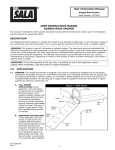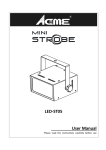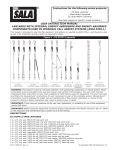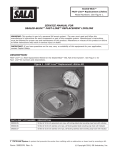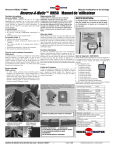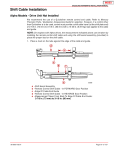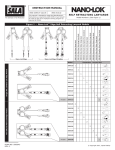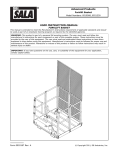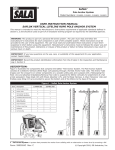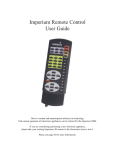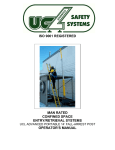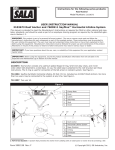Download SPECIFIC INSTRUCTIONS FALL ARREST DEVICES
Transcript
NOTIFIED BODY: No. 0086 BSI Product Services Kitemark House Mayland Ave Hemel Hempstead HP2 4SQ UK 9 EN360 SPECIFIC INSTRUCTIONS FALL ARREST DEVICES (Self Retracting Lifelines) EN Carefully read all instuctions for each component and General Instruction 5902392 before using this equipment FR Lire attentivement toutes les instuctions pour chaque composant et l’Instruction générale 5902392 avant d’utiliser ce matériel DE Lesen Sie sorgfältig alle Anweisungen für jede Komponente sowie Allgemeine Anweisung 5902392 bevor Sie diese Ausrüstung verwenden IT Leggere attentamente tutte le istruzioni di ogni componente ele istruzioni generali 5902392 prima di usare questo dispositivo ES Lea con atención todas las instrucciones para cada componente y la Instrucción general 5902392 antes de utilizar este equipo DA Læs omhyggeligt alle anvisningerne til hver komponent og Generel vejledning 5902392, inden dette udstyr tages i brug NO Les nøye gjennom alle instruksjonene for hver komponent og Generelle instruksjoner 5902392 før utstyret tas i bruk FI Lue jokaisen komponentin ohjeet ja Yleisohjeet 5902392 huolellisesti ennen näiden varusteiden käyttöä SV Läs noggrant alla anvisningar för varje komponent och allmän anvisning 5902392 innan du använder den här utrustningen Form No: 5902198 Rev E © Copyright 2008, DB Industries, Inc. 1 A B C D E F G H I J K 2 2 A B C D E F G H I 3 3 A B C d E F G H I 4 A B C D E F G 4 5 A B C D E F G H I J 5 6 A B C D E F G H I 6 7 A B C D H E G F I J 7 8 A B C D E F G I H J k L m N 8 9 A B A B A C B D E D E 10 A B C 11 CM 36.4 CM D E f 9 11 12 13 10 14 15 B B A B A C B B C a A 11 16 17 B A C D e 19 18 12 20 21 22 23 13 24 25 26 27 28 14 29 A 30 31 A A C B D 15 32 A D C B 33 B A 34 A G B E C H F D 16 35 A B C D 37 36 A A 17 GB Specific instructions—Self Retracting Lifelines You have just purchased a Capital Safety Brand PPE to provide fall protection for workers at height. We would like to thank you for your trust in our equipment. To enjoy the safety and comfort you expect, please keep and follow all instructions. All users and rescuers (see section 12 Terminology) are required to read this manual prior to use. See ‘Glossary’ in General Instructions for Use and Maintenance (GIUM) for identification of numbers in a white box. 1.0 Purpose/Descriptions Capital Safety Self Retracting Lifelines (SRL) are components in personal fall arrest systems (PFAS). These systems typically include a full body harness, anchorage connector (i.e. carabiner) and the SRL. Use in situations where worker mobility and fall protection is needed (inspection work, general construction, maintenance work, oil production, confined space work, etc.). Some models feature a retrieval option*. These models have standard fall arrest capabilities when used in their non-retrieval mode. In the retrieval mode these models may be used for emergency rescue (raising or lowering) of personnel within the capacity range stated below. It is also permissible to use retrieval models for raising and lowering of materials within the stated capacity range. • Sealed SRLs: Capital Safety Sealed SRLs incorporate a patented sealed technology that separates all dynamic components from foreign elements such as grease, moisture and dirt for safe operation under all working conditions. See Figure 1: A-Anchorage Handle, B-Instruction Label, C-Housing, D-Impact Indicator Label, E-ID Label, F-Cable Guide, G-Lifeline, H-Bumper, I-Ferrule, J-SelfLocking Snap Hook. ◊ Sealed SRLs with Retrieval Feature: See Figure 2: A-Retrieval Arm, B-Retrieval Handle, C-Handle Stowage Bracket, D-Pull Ring, E-Operation Label, F-Shift Knob, G-Retrieval Label, H-Pawl Cover, I-Torque Limiter Label. • Sealed-Blok™ SRLs: Includes cast aluminum housing and heavy gauge stainless steel or aluminum end plates, anti-racheting brake, built-in carrying handle (makes transport easy and provides a secondary “dropped objects protection” attachment point), large pivoting anchorage handle and self-locking swivel hook with impact indicator. See Figure 3: A-Anchorage Handle, B-Housing, CInstruction Label, D-Cable Guide, E-ID Label, F-Lifeline, G-Bumper, H-RFID Tag; I-Self-Locking Snap Hook. ◊ Sealed-Blok™ SRLs with Retrieval: See Figure 4: A-Retrieval Handle, B-Retrieval Label, C-Shift Knob, D-Locking Screw, E-Retrieval Arm (crank arm), F-Winch Operating Label, G-RFID Label. 18 IMPORTANT: Retrieval equipment may not be suitable for applications requiring frequent or continual use as a material hoist. Consult Capital Safety before using this product for such applications. The retrieval models are not designed to be used for general purpose work positioning or personnel-riding applications. • Ultra-Lok® SRLs: Capital Safety Ultra-Lok® SRLs come with a durable glass-filled polyurethane housing, wire rope or web lifeline and aluminum side plates for maximum durability and minimum weight. The systems have an anti-racheting twin disc brake system with an audio indicator to let you know it is functioning properly. ◊ ULTRA-LOK® WIRE & SYNTHETIC ROPE STYLE SRLs: Includes swivel eye anchorage attachment point, self-locking swivel snap hook with impact indicator, and choice of lifelines in galvanized or stainless steel wire rope, or synthetic rope. Wire rope lifeline lengths are available in 6.1, 9.1, 15.2 and 25.9 m. Synthetic rope lifeline lengths are available in 6.1, 10.7, and 16.8 m. See Figure 5: A-Swivel Eye; B-Inspection Note Label, C-Warning Label, D-Ultra-Lok Label, E-ID Label, F-Connections Label; G-Wire or Synthetic Rope; H-Bumper; I-RFID Tag; J-RFID Tag; K-Self-Locking Hook. ◊ LEADING EDGE SRLs: Includes swivel eye anchorage attachment point, self-locking swivel snap hook with impact indicator, integral shock pack, and 9.1 m galvanized wire rope lifeline. See Figure 6: A-Swivel Eye; B-Inspection Note Label, C-Warning Label, D-Ultra-Lok Label, E-Connections Label; F-Wire Rope; GRFID Tag; H-Shock Absorber; I-Self-Locking Snap Hook. • Note: Capital Safety SRL model 3504500 is designed for use in applications where falls may occur over an edge, such as roofing, leading edge construction, etc. This model is especially suited for use with a fall arrest system, using Capital Safety anchorage connectors intended for leading edge work. We recommend the 2105503 Swiveling Concrete Roof Anchor. ◊ ULTRA-LOK® WEB STYLE SRLs: Includes swivel eye anchorage attachment point, self-locking snap hook, and 2.54 cm wide nylon web lifeline in lengths of 3.4 m and 6.1 m. See Figure 7: A-Swivel Eye; Labels: B-Warning, C-ID, D-Impact Indicator, E-Connections, F-Reverse Lifeline; G-RFID tag; H-Web Lifeline; I-Indicator Fold; I-Connecting Hook. • SB Series SRLs: Includes heavy duty cast aluminum housing, anti-racheting disk brake system, high strength pivoting steel anchorage shackle, reserve lifeline retention and self-locking swivel snap hook with impact indicator. See Figure 8: A-Shackle; B-Impact Indicator, C-SALA Label, D-Impact Indicator Label, E-Warning Label, F-Specifications label, G-Instruction Label (left side), H-ID 19 Label, I-Instruction Label (right side); J-Wire Rope; K-RFID Tag; L-Tear Drop Thimble; M-Self-Locking Swivel Snap Hook; N-Hook options. important: See GIUM Sections 1.1 and 1.3 before using this equipment. Important: Before using this equipment, record the product identification information from the ID label (1) into the Equipment Identification Sheet at the end of the GIUM. 2.0 Requirements: Installation and use of this equipment is restricted by the following limitations: • capacity: One person. At no time shall more than one person connect to a single SRL for fall arrest applications. Retrieval applications can differ for each model. See Model Supplement for more information. • Locking Speed: Situations which do not allow for an unobstructed fall path should be avoided. Examples include: working in confined or cramped spaces, on slowly shifting material (such as sand or grain) or on a low pitched roof where a worker may slide instead of fall. These situations may not allow the body to reach sufficient speed to cause the SRL to lock if a fall occurs. A clear path is required to assure positive locking of the SRL. • environmental and physical hazards: Use of this equipment in areas with environmental hazards may require additional precautions to reduce the possibility of injury to the user or damage to the equipment. Hazards may include, but are not limited to: ◊ Corrosion: Do not leave this equipment for long periods in environments where corrosion of metal parts could occur as a result of vapors from organic materials. Use caution when working around sewage or fertilizer because of their high concentration of ammonia, which is very corrosive. Use near seawater or other corrosive environments may require more frequent inspections or servicing to assure corrosion damage is not affecting the performance of the product. ◊ Chemical: Solutions containing acids, alkali or other caustic chemicals, particularly at elevated temperatures, may damage DBI‑SALA SRLs. When working with such chemicals, frequent inspection of the entire SRL must be completed. Chemical damage to the lifeline is difficult to detect and it is recommended that the lifeline be replaced periodically to ensure safety. The lifeline may only be replaced by an authorized service center. ◊ Heat: This equipment is not designed for use in high tempera20 ture environments. Provide protection for this equipment when using near welding, metal cutting, or similar activities. Hot sparks may burn or damage this equipment. • Note: Synthetic rope lifelines are not flame proof and must not be exposed to extreme heat. Do not use the following in environments or contact surfaces over the specific temperatures given: • Spectra rope to 60° C • Vectran rope to 120° C ◊ Electrical: Due to the possibility of electric current flowing through the wire rope lifeline, use extreme caution when working near high voltage power lines. Contact Capital Safety if you have questions about using this equipment where environmental or physical hazards exist. important: Refer to applicable standards governing this equipment for more information on personal fall arrest or restraint systems and associated system components • compatibility of components: This equipment is designed for use with Capital Safety approved components and subsystems only. See also GIUM Section 1.12. • Compatibility of Connectors and making connections: Connectors (hooks, carabiners, D-rings) must be capable of supporting at least 22 kN. Connectors must be compatible with the anchorage and other system components and meet EN362 standards. See Figure 9: A-Anchorage; B-Connector; C-Anchorage Connector, D-Mounting Bracket; E-Tripod Leg. See also GIUM Section 5 and Figures for EN362. • anchorage strength: The anchorage strength required is dependent on the application type. Anchors must meet requirements of EN795. See also GIUM Section 12. • Horizontal system: In applications where an SRL is used in conjunction with a horizontal system (i.e. horizontal I-beams and trolleys), the SRL and horizontal system components must be compatible. Horizontal systems must be designed and installed under the supervision of a qualified engineer. • Optional retrieval system: When using an SRL with an optional retrieval system, ensure the support structure (i.e. tripod, davit arm) is compatible with the connection, operation, stability and strength of the SRL. See Figure 10-Optional Mounting for Model 3400614: A-Hex Lock Nut, M12 x 1.75, Zinc Plated (ZP); 21 B-Hex Head Bolt, M12 x 1.75 x 25 cm, Metric Nut Class 8.8, ZP; C-Mounting surface; D-use washers as required; E-Washer, 12 mm, ZP, 5 typical; F-Hex Head Bolt, M12 x 1.75 x 8 cm, Metric Nut Class 8.8, ZP. 3.0 Training It is the responsibility of the users of this equipment to understand these instructions, and to be trained in the correct installation, use, and maintenance of this equipment. This user manual is not a substitute for a training program. Important: Read GIUM Section 1.1 regarding training. 4.0 Planning Before each use: Read GIUM Section 1.1 “Before each use” and carefully inspect the SRL to assure it is in good working condition by following the steps in Section 7.0. In addition do the following: • Ensure all bolts are present and secure. • Pull out the line and allow it to slowly retract. If there is any hesitation in retraction, the unit should be returned to Capital Safety for service. • Check the locking action by pulling sharply on the line. • Do not use if inspection reveals an unsafe condition. Important: Read GIUM Sections 1.3, 1.4, 1.12 when planning your system. Planning: Plan your fall protection system before starting your work. Consider factors that may affect your safety before, during, and after a fall. The following list gives some important points to consider: • Anchorage: Select a rigid anchorage point (see Figure 9). See more on anchorage strength in Section 2.0. Carefully select the anchorage location to reduce free fall and swing fall hazards. Optional Mounting for Retrieval Systems is covered in Section 2.0. IMPORTANT: Only SRLs that can be used in a horizontal mode (indicated by labeling), such as the Leading Edge SRL, may be anchored at foot level or above. See Figure 12. All other SRLs must be anchored above the full body harness attachment (indicated by labeling). See Figure 11 • Swing Falls: Swing falls occur when the anchorage point is not directly above the point where a fall occurs. See Figure 13. The forces of striking an object in a swing fall may cause serious injury. In a swing fall, the total vertical fall distance will be greater than if the user had fallen directly below the anchorage point, thus increasing the total free fall distance and the distance required 22 to safely arrest the user. The SRL will activate regardless of its orientation relative to the user. Review your specific application to determine what the appropriate work zone should be. Minimize swing falls by working as directly below the anchorage point as possible. Never permit a swing fall if injury could occur. If a swing fall situation exists in your application contact Capital Safety before proceeding. • FALL CLEARANCE: Ensure adequate clearance exists in your fall path to prevent striking an object. The minimum clearance is 4.5 m from the dorsal D-ring level to the next level of obstruction or object. See Figure 14. Additional clearance is required if potential swing fall exists. • SHARP EDGES: Avoid working where the lifeline will be in contact with or abrade against unprotected sharp edges. Provide protection for the lifeline when possible. An energy absorbing component can sometimes be added in-line to further protect the worker. Compatibility and total fall distance must be considered if this is done. Contact Capital Safety before using an in-line energy absorbing component or lanyard with an SRL. IMPORTANT: Even though the Leading Edge SRL (Model 3504500) provides additional protection from falls occurring over edges, protection against cutting must be provided when working near extremely sharp edges such as sheared, cold rolled, or flames cut steel. Edge protection is not required over edges such as hot rolled steel, steel decking, concrete, or wood. • RESCUE: If a fall occurs, the employer must have a rescue plan and the ability to implement a rescue. • AFTER A FALL: Equipment which has been subjected to fall arrest forces must be removed from service for inspection. See Section 7. • Other Considerations: Avoid working where your lifeline may cross or tangle with that of another worker. Do not allow the lifeline to pass under arms or between legs. Never clamp, knot or otherwise prevent the lifeline from retracting or being taut. Avoid slack line. Do not loop the lifeline around small structural members. Important: Read and follow manufacturer’s instructions for associated equipment (i.e. full body harness) used in your personal fall arrest system. Important: For special (custom) versions of this product, follow the instructions provided in this manual. See supplement, if included, for additional instructions when using a customized product. 23 5.0 Assembly and Installation • BODY SUPPORT: When using Capital Safety SRLs a full body harness (EN361) must be worn. For general fall protection use, connect to the dorsal (back) D-ring between the shoulders. ◊ Retrieval Operations: It is recommended that a full body harness be used to retrieve the victim, assuming their medical condition allows for such retrieval. Models are available with retrieval connections (shoulder D-rings) on top of the shoulders to aid in rescue operations. warning: Body belts are not allowed for free fall situations. They increase the risk of injury during fall arrest in comparison to a full body harness. Limited suspension time and the potential for improperly wearing a body belt may result in added danger to the user’s health. See also GIUM Section 2.0 • MAKING CONNECTIONS: When using a hook or carabiner to make a connection, ensure roll-out cannot occur. See Section 2.0, “Compatibility of Connectors.” See Figure 15. Use a locking snap hook or carabiner (A) that will completely close over the anchorage (B) or anchorage connector (C). It is recommended that the Model 340614 attach to a structure in a fixed position (vs. hanging) with the hardware supplied. The mounting surface should meet the anchorage strength requirements stated in Section 2.0, “Anchorage Strength.” Follow the manufacturer’s instructions supplied with each system component. 6.0 USE See Figure 16. Connect the SRL (A) to a suitable anchorage (B). Connect the self-locking snap hook (C), to the fall arrest or ladder climbing attachment (D) on the full body harness (E). See Figure 17. Ensure connections are compatible and hook is fully closed and locked. Once attached, the worker is free to move about within the recommended working area at normal speeds. The lifeline should extend smoothly and retract without hesitation. The lifeline must remain taut at all times during normal use. If slack line condition is created during normal use, the unit should be returned to Capital Safety for service. If a fall occurs, the SRL will lock and arrest the fall. Warning: Upon rescue, remove the SRL from use. See GIUM Section 1.2. Inspect as described in Section 7.0, “After Fall Arrest.” When working with an SRL, always allow the lifeline to recoil back into the device under control. A short tag line may be required to extend or retract the lifeline during connection and disconnection. Allowing the lifeline to be fully extended for long periods of time may cause premature weakening of the retraction spring. 24 • Retrieval System Operation (Models 3400101, 3400102, 3400301, 3400302, 3400501, 3400502): Figure 17 shows how to activate the retrieval mode. Remove the retrieval handle on the back side of the SRL by pushing the release button on top of the handle and pulling upward. Install the pin into the hole on the end of the retrieval arm. Rotate the arm assembly to the side to access the shift knob. Lift the pull ring (on the shift knob) and rotate it counterclockwise 1/8 turn and release. Rotate retrieval arm clockwise to aid engagement. The shift knob should move inward and rotate to a locked position when drive is fully engaged. ◊ To Raise: Rotate retrieval arm counterclockwise. ◊ To Lower: Rotate retrieval arm clockwise. Keep tension on lifeline at all times (34 kg. minimum). Important: A minimum load of 34 kg is required for lowering or to pay out line. IMPORTANT: If a fall occurs in the fall arrest mode and the worker must be lowered to safety, raise the worker slightly to release the locking pawls and lower the worker. IMPORTANT: Do not continue to rotate the retrieval arm in the lowering direction after the cable is fully extended. Spring damage may occur. ◊ Disengagement of retrieval mode: Remove load from the lifeline. Rotate the shift knob counterclockwise 1/8 turn, pull ring out, rotate shift knob clockwise 1/8 turn. Release pull ring. Remove retrieval handle from retrieval arm and stow in stowage bracket. Insert retrieval handle pin through handle and into stowage bracket. ◊ Retrieval overload feature: SRLs incorporating the retrieval feature (as shown in Figure 17) are provided with an overload clutch which protects the drive components and the person being raised from excessive force. This same feature provides shock absorption for the user if a fall occurs when the retrieval mode is engaged. The overload clutch is set to slip at approximately 227 kg. to allow for emergency rescue applications where additional lifting capacity is required. Important: Capacity for retrieval operation is 210 kg. 25 IMPORTANT: Operating the retrieval system at loads greater than the rated capacity reduces the overall safety factor. Any unit which has been used above the rated capacity must be removed from service and returned to Capital Safety for inspection. ◊ Mounting Retrieval Models: The SRL retrieval models as shown in figure 1 and 2, may be used with optional brackets (Capital Safety Part Numbers 3401123 and 3401090) for mounting to the Capital Safety tripod, davit arm, or ladder mast. Follow the steps below for mounting and use of these brackets. IMPORTANT: If mating bracket for tripod leg is not attached, position clamp plate assembly in desired location on leg and tighten bolts to 20 Nm. Do not overtighten. Step 1. Attach the bracket to the SRL by inserting the two furnished bolts through the holes in the SRL housing. Attach nuts and secure. See Figure 18. Step 2. After the bracket is secured to the SRL, position the SRL bracket assembly onto mating bracket of tripod, davit arm, or ladder mast. The slot in the end of SRL bracket slides onto the pin extending out each side of the mating bracket. Reposition the tripod leg bracket as required for proper operating height. See Figure 19. Step 3. With assembly resting on pin, pivot top of SRL inward to align holes. Press in button on the end of the detent pin and slide pin in fully to secure SRL assembly to tripod, davit arm, or ladder mast. See Figure 20. Step 4. Extend cable up support structure and over pulleys. Reinstall detent pins near pulley to prevent cable from sliding off pulleys. See Figure 21. Figures 22 and 23 show a completed attachment. • Retrieval SYSTEM OPERATION (Models 340854 and 340855): Figure 4 identifies key components of the retrieval system. To activate retrieval mode, rotate the locking screw (D) down completely to free the crank arm (E). Pivot the handle (A) out from the stowed position. To engage the winch, pull and hold the shift knob (C) in the unlocked position. Push the crank arm (E) in to the engaged position and release the shift knob (C). If needed, rotate the crank arm clockwise (lowering) to aid in gear engagement. ◊ To Raise: Rotate the crank arm counterclockwise. ◊ To Lower: First crank the crank arm counterclockwise to release the fall arrest brake, then crank clockwise. 26 important: A minimum load of 34 kg is required for lowering or to pay out line. A force on the retrieval handle of up to 13 kg is required to operate the winch when loaded to capacity. caution: Stop cranking when line is fully extended or retracted. Continued cranking can damage components. ◊ Disengagement of retrieval mode: Remove any load from the lifeline. Pull and hold the shift knob in the unlocked position. Pull the crank arm out to the disengaged position and release the shift knob. Secure the crank arm with the locking screw. Pull out on the retrieval handle and rotate the handle to the stowed position. ◊ Retrieval overload feature: Winches on the SRL models (as shown in Figure 4) do not incorporate an overload clutch to limit the force applied to the drive components and the person being raised. Care must be taken to avoid line slack while in rescue mode. Also, the individual must be monitored during retrieval to ensure they do not become stuck and subjected to excessive force from continued lifting. IMPORTANT: Operating the retrieval system at loads greater than the rated capacity reduces the overall safety factor. Any unit which has been used above the rated capacity must be removed from service and returned to Capital Safety for inspection. ◊ Mounting Retrieval Models: The SRL retrieval models (as sjpwm om Figures 3 amd 4) may be used with an optional bracket (Model 3401025) for mounting to the Capital Safety tripod, davit arm, or ladder mast. Follow the steps below for mounting and use of this bracket. IMPORTANT: If mating bracket for tripod leg is not attached, position clamp plate assembly in desired location on leg and tighten bolts to 20 Nm. Do not overtighten. Step 1. Remove the three set screws plugging the holes in the side of the SRL housing. See Figure 24 Step 2. Attach the bracket to the SRL by inserting the three bolts through the holes in the SRL housing. See Figure 25 Step 3. After the bracket is secured to the SRL, position the SRL bracket assembly onto mating bracket of tripod, davit arm, or ladder mast. The slot in the end of SRL bracket slides onto pin extending out each side of mating ladder mast, davit arm, or tripod leg bracket. Reposition tripod leg bracket as required for proper operating height. See Figure 26. 27 7.0 Step 4. With assembly resting on pin, pivot top of SRL inward to align holes. Press in button on end of detent pin and slide pin in fully to secure SRL assembly to tripod, davit arm, or ladder mast. See Figure 27. Step 5. Extend cable up support structure and over pulleys. Reinstall detent pins near pulley to prevent cable from sliding off pulleys. See Figure 28. INSPECTION The i-Safe™ RFID tag on SRLs (A) can be used in conjunction with the i-Safe handheld reading device and the web based portal to simplify inspection and inventory control and provide records for your fall protection equipment. See Figure 29. • FREQUENCY: Before each use inspect SRL according to the inspection steps below. SRLs must be inspected by a competent person, other than the user, at least annually. If you are a firsttime user, contact a Customer Service representative or if you have already registered, go to: www.capitalsafety.com/isafe.html. Follow instructions provided with your i-Safe handheld reader or on the web portal to transfer your data to your web log. Record the results of each formal inspection in the Periodic Examination and Repair History in the GIUM (5902392) or use the i-Safe™ inspection web portal to maintain your inspection records. See GIUM Section 4. A record of annual service dates can be found on the SRL labels. ◊ After Fall Arrest: Inspect load impact indicator and entire SRL. ◊ After Use of Retrieval Mode: After raising or lowering, inspect the load impact indicator and entire SRL. Applications which require continuous raising and lowering may require increased inspection and servicing frequency. Contact Capital Safety if you have any questions regarding inspection frequency. WARNING: See GIUM 1.2 if the SRL has been subjected to fall arrest or impact forces. IMPORTANT: Extreme working conditions (harsh environment, prolonged use) may require increasing the frequency of inspections. • General INSPECTION STEPS: Step 1. Inspect for loose screws, bolts and bent or damaged parts. Step 2. Inspect housing for distortion, cracks, or other damage. UltraLok Models Only: Ensure the swivel eye is not 28 damaged or distorted in any way. Ensure the swivel eye turns freely. SB Series Only: Ensure the shackle moves freely and is free from distortion, cracks, burrs and worn parts. Ensure the athe nut is fully tightened. Step 3. Inspect the load impact indicator. This inspection is dependent on the type of SRL used. Follow the detailed instructions for your SRL type: ◊ UltraLok Cable and Rope Style SRLs: See Figure 30. Inspect the impact indicator (A). In “normal mode” (B) you should look for exposed color band (C) on the hook. If the hook is in the “indicated mode” (D), an impact loading has occurred. • Note: Do not attempt to reset impact indicator. Swivel will not turn freely in “indicated mode.” ◊ SB SRLs: See Figure 31. Check the red impact indicator button (A), to be sure it is flush with the housing. If the button is not flush with the housing, the block has been deployed. ◊ UltraLok Web Style SRLs: See Figure 32. These SRLs incorporate an impact indicator in the web lifeline (A). The web near the hook end (B) of the lifeline is folded onto itself and stitched with red thread, forming a small loop (C). The stitched loop will pull out at approximately 1.6 kN. If the red stitching is intact, the SRL has not been impacted. If the red stitching has been broken and the loop torn apart (D), the SRL has been impact loaded. ◊ UltraLok Leading Edge Style SRLs: See Figure 33. The 3504500 leading edge style SRLs incorporate an integral energy absorbing component. Inspect the energy absorber to determine if it has been activated. There should be no evidence of elongation (B). Ensure energy absorber cover (A) is secure and not torn or damaged. WARNING: If inspection reveals a defective condition, remove SRL from service immediately and contact an authorized service center. Step 4. Lifeline should pull out and retract fully without hesitation or creating a slack line condition. The lifeline must be taught (under tension). Step 4. Ensure device locks up when lifeline is jerked sharply. Lockup should be positive with no slipping. Step 5. The labels must be present and fully legible. See Model Supplement. Step 6. Look for signs of corrosion on the entire unit. Step 7. Inspect lifeline. 29 ◊ Wire Rope Models: See Figure 34. Inspect lifeline for cuts, kinks (A), broken wires (B), bird-caging (C), corrosion, welding splatter (D), chemical contact areas, or severely abraded areas. Slide up cable bumper and inspect ferrules for cracks or damage and inspect wire rope for corrosion and broken wires. • Note: Replace the wire rope assembly if there are six or more randomly distributed broken wires in one lay, or three or more broken wires in one strand in one lay. A “lay” of wire rope is the length of wire rope it takes for a strand (the larger groups of wires) to complete one revolution or twist along the rope. Replace the wire rope assembly if there are any broken wires within 25mm of the ferrules. ◊ Web or Synthetic Rope Models: See Figure 34. Inspect lifeline for concentrated wear, frayed strands (E), broken yarn, burns (F), cuts (G), and abrasions. The lifeline must be free of knots throughout its length. Inspect for excessive soiling (H), paint buildup, and rust staining. Inspect for chemical or heat damage indicated by brown, discolored, or brittle areas. Inspect for ultraviolet damage indicated by discoloration and the presence of splinters and slivers on the lifeline surface. • NOTE: All of the above factors are known to reduce rope strength. Rope strength is reduced proportional to the crosssectional area of the rope damaged. Damaged or questionable ropes must be replaced. WARNING: Do not tie or knot lifeline. Avoid lifeline contact with sharp or abrasive surfaces. Inspect lifeline frequently for cuts, fraying, burns, or signs of chemical damage. Dirt, contaminants, and water can lower dielectric properties of the lifeline. Use caution near power lines. Step 8. Inspect connecting hooks, if present, for signs of damage, corrosion, and working condition. Swivel should rotate freely. Step 9. Inspect the reserve lifeline payout, if present, by checking indicators: ◊ Wire Rope Lifeline Models (Excluding SB Series): See Figure 35: A-Cable Guide; B-Cable Stop; C-Cable Guide Sleeve; D-Bumper. See Figure 36: A-Reserve Lifeline Red Band. If a fall has been arrested when most of the lifeline was out, it is possible that the reserve lifeline has been deployed. To inspect for reserve lifeline deployment, pull lifeline out of the SRL until it stops. If the red band indicator is visible, the reserve lifeline has been deployed. If the reserve lifeline has not been deployed, that portion is acceptable and the inspection can continue. ◊ SB Series Models: These SRLs do not have a reserve lifeline feature. 30 ◊ UltraLok Web Lifeline Models: Inspect the reserve lifeline payout. If a fall has been arrested with most of the lifeline out, the reserve lifeline may have been deployed. Pull the lifeline out of the SRL until it stops. If the reserve lifeline label (F) is visible, as shown in Figure 7, the reserve lifeline is deployed and the unit must be serviced by an authorized service center before reuse. If the reserve lifeline has not been deployed, continue with inspection. ◊ Synthetic Rope Lifeline Models: Inspect the reserve lifeline payout. If a fall has been arrested, it is possible the reserve lifeline has been deployed. To inspect for reserve lifeline deployment, pull lifeline out of the SRL until it stops. If the reserve lifeline warning label (A) is visible, the reserve lifeline has been deployed. See Figure 37. If the reserve lifeline has not been deployed (the reserve lifeline label is not visible) that portion is acceptable and the inspection can continue. Important: If indicators are visible, the unit must be serviced by an authorized service center before reuse. Step 10. Inspect each system component or subsystem according to manufacturer’s instructions. • INSPECTION STEPS FOR RETRIEVAL COMPONENTS: (MODELS 3400101, 3400102, 3400301, 3400302, 3400501, 3400502) See Figure 2 Step 11. Inspect retrieval arm (A) for distortion or other damage. Retrieval handle (B) should engage into retrieval arm with ease and push button should work freely. Step 12. Shift knob (F) should rotate freely when engaging/ disengaging. Pull ring (D) on shift knob should spring back when released. Step 13. Inspect retrieval mode for operation. To test, raise and lower a test weight (sand bag) of between 34 kg and 141 kg. Retrieval operation should be smooth and even. When the retrieval handle (B) is released, the weight should not move and retrieval handle should stay in position (no movement). A “clicking” sound should be evident when raising load. Step 14. The pawl cover (H) (see Figure 3) must be secure and without deformation. Optional mounting bracket must be securely attached to SRL and free from defects. Detent pin must operate freely. 31 • INSPECTION STEPS FOR RETRIEVAL COMPONENTS: (Models 340854 and 340855) See Figure 4 Step 11. Inspect the retrieval arm (E) for distortion or other damage. Ensure that the retrieval handle (A) can be rotated out and secured in the cranking position. Step 12. Ensure the locking screw (D) can be tightened completely. Step 13. Ensure the shift knob (C) can be pulled out to the unlocked position and then released, locking the crank arm (E) in both the engaged and disengaged positions. Step 14. Test the retrieval mode for proper operation by raising and lowering a test weight of between 34-141 kg (sand bag). Retrieval operation should be smooth and even. When the retrieval handle (A) is released, the weight should not move and the retrieval handle (A) should remain in position (no movement). A “clicking”sound should be evident when raising the load. • Procedure for Defective Condition: See GIUM Sec. 1.2. Important: Only Capital Safety or parties authorized in writing may make repairs to this equipment. 8.0 Product Life As long as the SRL passes inspection by a competent person1, it may remain in service. See GIUM 4.2 and Section 1.16 for warranty information. 9.0 MAINTENANCE, STORAGE, Transport (See GIUM Sec. 3) • Maintenance ◊ Position the SRL so excess water can drain out. ◊ Clean labels as required. ◊ Follow GIUM Sections 3.1 and 3.2. An excessive buildup of dirt, paint, etc. may prevent the lifeline from fully retracting back into the housing causing a potential free fall hazard. Replace lifeline if excessive buildup is present. ◊ Do not lubricate any parts. Warning: If the lifeline contacts acids, remove unit from service and wash with water and mild soap solution. Inspect unit before returning to service. 1 Competent Person: An individual who is knowledgeable of a manufacturer’s recommendations, instructions, and manufactured component who is capable of identifying existing and predictable hazards in proper selection, use, and maintenance of fall protection 32 • STORAGE: See GIUM Section 3.3. Thoroughly inspect the SRL after any period of extended storage. • TRANSPORT: See GIUM Section 3.4 10.0 Service Lifeline replacement, as well as additional maintenance and servicing procedures, must be completed by an authorized service center. An authorization and return number must be issued by Capital Safety. Do not disassemble the SRL. See Section 7.0 for inspection frequency. 11.0 Specifications and labels (See Model supplement) 12.0 Terminology Rescuer: Person or persons other than the rescue subject acting to perform an assisted rescue by operation of a rescue system. Competent person: See GIUM Section 16. 33 78 3000057 3000058 3000059 3000061 3000070 3000071 3000072 3000075 3000076 3000077 3000150 3000151 3000152 3000153 3103116 3103229 3400001 3400002 3400101 3400102 3400201 3400202 3400301 3400302 3400401 3400402 3400501 3400502 3400518 3400519 3400614 3400803 3400804 3400854 3400855 3504430 3504431 3504432 3504433 3504434 3504436 3504437 3504438 3504439 3504440 3504450 3504451 3504452 3504480 3504485 3504486 3504487 3504488 3504500 3505694 3505695 3505696 3505697 3505698 3505699 7211510 7211511 7211512 7211513 7211514 7211515 A Capital Safety Company CSG USA 3833 Sala Way Red Wing, MN 55066-5005 CSG Canada Ltd. 260 Export Boulevard Phone: 651.388.8282 Fax: 651.388.5065 [email protected] Mississauga, Ontario L5S 1Y9 Canada Phone: 905.795.9333 Fax: 905.795.8777 [email protected] CSG Northern Europe Ltd. 7 Christleton Court • Stuart Rd. CSG EMEA (France) CSG Asia Pte Ltd. CSG (Aust) Pty Ltd. Le Broc Center Z.I. 1ère Avenue-5600 M BP 15 • 06511 Carros Cedex Phone: +33 (0)4 97 10 00 10 Fax: +33 (0)4 93 08 79 70 [email protected] No. 6, Tuas Avenue 18 Singapore 638892 Phone: +65 6558 7758 Fax: +65 6558 7058 [email protected] www.capitalsafety.com Manor Park • Runcorn Cheshire WA7 1ST • UK Phone: +44 (0) 1928 571324 Fax: +44 (0) 1928 571325 [email protected] 20 Fariola Street • Sliverwater Sydney, NSW 2128 Australia Phone: +61 (2) 9748 0335 Fax: +61 (2) 9748 0336 [email protected]


































